
In February 2009, the Pentagon decided to lift the two-decade long ban on photographs of flag-draped coffins. Somewhere down the line the military brass reasoned (or was forced to admit) that it was contradictory to champion “Operation Iraqi Freedom” while denying the media the freedom to publish images of soldiers returning home in caskets. Apparently, Jeffrey Deitch missed the memo that censoring anti-war images of coffins is something that democratic societies do not take kindly to.
For those not versed in the latest art world controversy, Museum of Contemporary Art Los Angeles director Jeffrey Deitch launched a pre-emptive strike on a mural by the Italian street artist Blu that he had commissioned him to paint on the side of the Geffen Contemporary building. Deitch objected to the content of the mural – a series of coffins draped with dollar bills, instead of flags, because he felt that it might upset the Japanese-American community and the veteran community. “There were zero complaints, because I took care of it right away,” explains Deitch. “This is 100% about my effort to be a good, responsible, respectful neighbor in this historic community.” (1) Immediate neighbors to the mural wall include the LA Veterans’ Affairs Hospital and the “Go For Broke” monument, a patriotic monument that celebrates the role of Japanese American soldiers who served in Europe and the Pacific during World War II. Deitch asked Blu to repaint another image, the artist refused, and an art controversy was born. Deitch’s decision, however, runs deeper than a museum director censoring an artist: it censors debate on the impact of war at home and abroad, and suggests that street artists who are still begging to take Blu’s place in Deitch’s soon-to-be blockbuster show Art in the Streets have lost much of their subversive edge when they play by the museums rules.
Community Art Controversies without a Community Outcry
Blu’s impressive mural at MOCA deviated little from the majority of his work that critiques war and capital. His image presented war as a ruthless business enterprise where young men and women are sent off to battle (and sent home in coffins) while corporations reap massive rewards. Conversely, the mural read as an economic critique about the financial cost of the Iraq and Afghanistan Wars that have cost the US public over $1.09 trillion dollars and counting. Lastly, one could even read the coffins as a metaphor for the commercialization of street art – a once subversive genre covered in money and showcased in elite cultural institutions.
These politicized readings make Blu an odd choice for a show that will likely stress the familiar cast of (street) art world stars (Banksy, Shepard Fairey, Barry McGee, Swoon, etc), than a critical look at society and/or the medium itself. That said, Blu’s work remains palatable to the world of high art. His drawing style is rooted in familiar contemporary art forms and his international reputation overrides the concerns that most museum curators and directors would have with his content. This appears to be the case with Deitch. He never asked to see a sketch of Blu’s mural, nor was he present when the mural when up, away at Art Basel in Miami – a.k.a. the annual G20 meeting for the art world. When Deitch returned, he took one look at the mural and asked the artist to repaint the wall with a new image, a request that Blu thankfully refused to do.
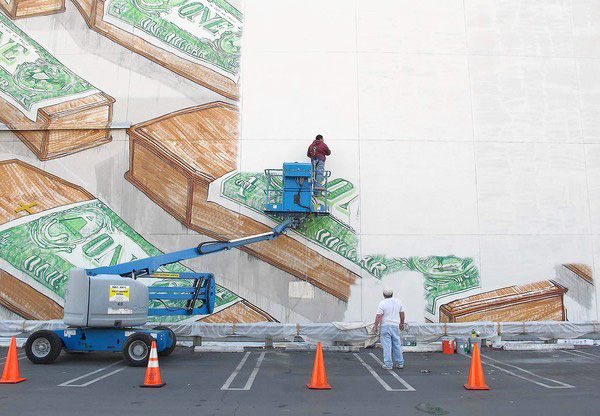
Deitch’s request was a precautionary measure to make sure that the museum did not upset the Japanese American community in the Little Tokyo community, or the veterans at the VA Hospital. One might have expected that Deitch would have waited for any type of community outcry, or held a public forum on the mural, but this did not happen. He explains his reasoning for prompt action as such, “Out of respect for someone who is suffering from lung cancer, you don’t sit in front of them and start chain smoking.” (2) The problem with this logic is that he assumes that all Japanese Americans and all veterans think alike: i.e. they are uncritical of war and easily offended by anti-war art.
If anything, the opposite is the case. Veterans are arguably the one segment of the population that is the most vocal about war, especially opposition to war. Organizations like Iraq Veterans Against the War (IVAW) are at the forefront of the anti-war movement, which comes as no surprise considering the hell that veterans and active duty soldiers have gone through. Close to twenty percent of all soldiers who return from Iraq and Afghanistan have Post-Traumatic Stress Disorder (PTSD) and nearly one-third of all women in the military have been sexually assaulted. According to the VA, more than 48,000 female veterans screened positive for Military Sexual Trauma (MST) in 2008.
These factors have contributed to a suicide epidemic amongst veterans. Reported suicide attempts have jumped 500 percent between 2002 and 2007. In 2005, 6,256 US veterans (of all wars) took their lives. Oregon provides just one example of how the experience of war can forever scar an individual. In 2005, 19 Oregon soldiers died in combat in Iraq and Afghanistan. That same year, 153 Oregon veterans (of various wars) committed suicide. These statistics are shocking, yet remain grossly under-reported and are essentially erased from the public’s conscience.
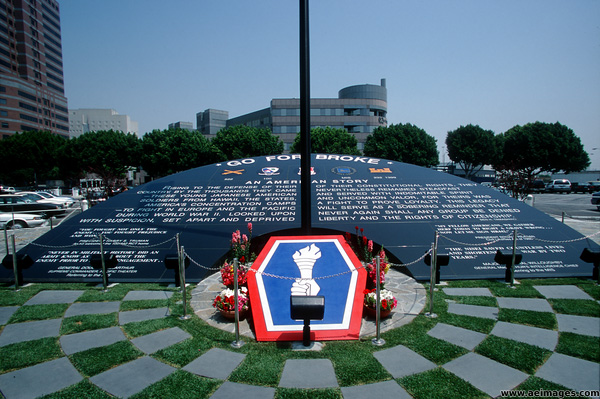
Go For Broke Monument, Los Angeles
One can also critique Deitch’s decision not to offend the Japanese American community in Little Tokyo, for this too assumes that the community is only comprised of flag waiving patriots who would be offended by an anti-war statement. In reality, the Little Tokyo neighborhood cannot be generalized. Sure, a heroic monument to war and patriotism exists in the neighborhood, but so does voices that are more critical of war, along with a myriad of opinions in between. Central to the Little Tokyo neighborhood is the Japanese American National Museum, a museum that routinely features exhibits about the painful history of Japanese Americans who were placed in internment camps during World War II under the orders of President Roosevelt. During this period the patriotism of Japanese Americans was put into question. Thousands of Japanese Americans were rounded up, lost their homes and businesses, and placed into prison camps. One must assume that the patriotic monument of Japanese Americans serving in WWII was created as a response to the backlash that the community faced for being falsely labeled as unpatriotic in the 1940s. Yet, assuming that the community blindly supports war and is not divided over any number of political and cultural issues, both then and now, is equally offensive. This is the trap that Deitch has fallen into, the trap of generalizing an entire community. Instead of siding with the artist he chose not to risk the chance that anti-war images might upset some people. Yet, isn’t that the role of art? To challenge people to critically engage with issues that matter? For what’s more offensive – endless wars and a suicide epidemic amongst veterans, or art that some people might find unpatriotic?
Art In the Streets – Street Art in a Museum
The erasure of Blu’s mural is deeply disappointing. Equally offensive is the parade of artists and cultural producers who have come to the defense of Deitch arguing that Art In the Streets is too important to be derailed by a mural controversy. Shepard Fairey, no stranger to idiotic quotes, recently stated in the Los Angeles Times, “I’m not a fan of censorship but that is why I, and many of the other artists of the show, chose to engage in street art for its democracy and lack of bureaucracy” (3) He adds:
a museum is a different context with different concerns. It would be tragic for the break through of a street art /graffiti show at a respected institution like MOCA to be sabotaged by public outcry over perceived antagonism or insensitivity in Blu’s mural. Graffiti is enough of a contentious issue already. The situation is unfortunate but I understand MOCA’s decision. Sometimes I think it is better to take the high road and forfeit a battle but keep pushing to win the war. Street art or graffiti purists are welcome to pursue their art on the streets as they always have without censorship. I think that though MOCA wants to honor the cultural impact of the graffiti/street art movement, it only exists in its purist form in the streets from which it arose. (4)
Fairey has somehow surmised that the MOCA show will somehow help the overall cause of street art, instead of just himself. Imagine, if you will, politicians and police departments from around the country saying “Thank you MOCA, thank you for putting your stamp of approval on the art form, we now love graffiti, kids be free, grab your spray paint and cover the city. Maybe one of you will be the next Banksy and we can develop a tourist strategy around this wonderful art form that we once misunderstood.”
Fairey is not alone in pronouncing that the show will improve street art’s bad rap. Graffiti photographer-chronicler Henry Chalfant writes:
When I first heard about MOCA buffing Blu’s mural I was incredulous and angry. Since then I’ve gotten a more nuanced view of the situation. I understand and accept Jeffrey Deitch’s explanation of the circumstances that led to the mural’s destruction. It was a curatorial error not to have communicated to the artist the nature of the wall’s location before it was painted, but MOCA couldn’t have left the mural there as an affront to the community who considered it sacred ground, and who, in no way, were the deserving targets for the mural’s powerful message. With street art, context is all important. I would have loved to see the mural in front of the offices of Halliburton-KBR or on Wall Street, for America’s war profiteers to see. For everyone involved, it is a great sadness that this work of art by a brilliant artist has been destroyed. I do not easily accept its destruction. But think of this. Losing the mural is sad enough and that misfortune will be compounded if the street art exhibition is canceled because the artists drop out to express their outrage. That would be self-defeating. (5)
The editors of the Wooster Collective offer a more sensible critique on the mural controversy:
As time goes on, more and more of our museums fail to live up to the ideals that we have for them. We want, and expect, museums to defend our free speech. We want, and expect, museums to provide a home for provocative thought. We want, and expect, museums to provoke and inspire debate. What we should not want is for museums to be so constrained and commercial that they add very little to the public debate. (6)
Yet, their critique falls short when they write:
But the bottom line is this – EVERY artist wants to be recognized by their peers and the public at large. One would be hard-pressed to find any artist – including graffiti and street artists – who didn’t want to do everything they could to be included in a museum’s collection. Museums mean that you are part of history. All artists want to be part of history, especially graffiti and street artists. (7)
This statement epitomizes the ugly marriage of street art and the commercial art world. It reads like a quote from a starry-eyed art student who aspires to be in Art Forum to help he or she “make it” — an artist who looks to the cultural brokers of the commercial art world to validate their work and their existence.
The Wooster Collective quote is also so self-defeating for it asserts Deitch’s power to do as he pleases. Deitch can rest assured that the Blu mural controversy will be a blip-on-the-radar for he holds the keys to what many street artists want: an invitation to be part of Art in the Streets. One would hope that artists would rally to Blu’s defense and use the censorship case as a chance to boycott the show, a tactic that might lead to changes, but the opposite seems to be the case: artists overjoyed that a new roster spot is open! This line of thinking simply allows museum directors to continue business-as-usual.
More so, the Wooster Collective quote re-enforces a trend in street art that is hard to ignore: street art as a development league for the commercial art world. Call me crazy, but aren’t there larger goals for street artists to reach for than acceptance by museums? For one, how about art that truly makes a difference in a community? Or art that plays a major role in the success of a movement, or better yet, art that helps transform society? Aren’t these goals more important than simply getting ones work into a museum collection? And shouldn’t getting work into a museum, be at best, a secondary concern, not a primary one?
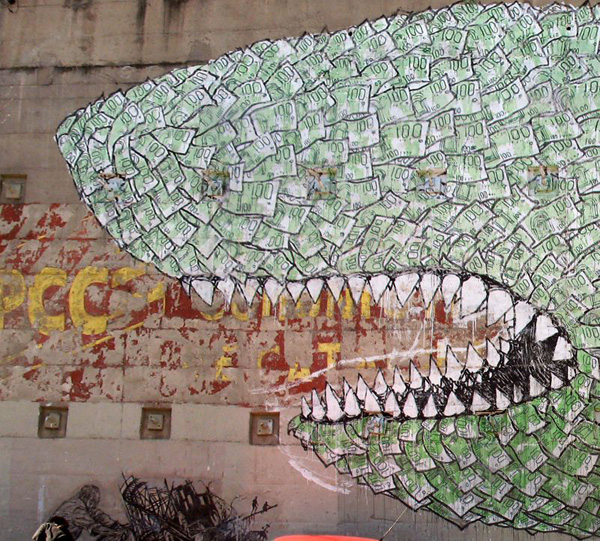
Blu mural, Barcelona.
To me, street art is at its best when it expresses political views and rails against power, privilege, and private property. For others, the goals have become more blurred, which is not surprising considering how intertwined street art has become with gallery art. The problem is that many want to have it both ways: street art credibility and museum recognition. They want the medium to stay pure, yet expect the museum to also be pure when it is their time to sneak through the doors of guarded culture. They want the museum to change and be more reflective of the artist’s views, but that is not how the power dynamic works – power sides with the museum. Furthermore, any art that enters the museum takes on a new context when it becomes part of an exhibition or the collection. This is especially so with street art considering its roots, primary location in urban spaces, and politics that are, correctly or not, identified with rebellion and dissent.
Street art in museums and commercial art galleries loses much of its rebellious nature. I would be shocked if Art In the Streets reaches beyond anything but a gala celebration of the genre. An ominous sign is the name itself that ideally should have been titled “Street Art in a Museum.” That name alone might have suggested a more critical exhibition, one that would take a critical look at street art and its history and ask the tough questions. For starters, what happens when a subculture gets too cozy with the brokers of cultural and economic power, be it street artists showing in major museums or designing products for corporations? What happens when a genre becomes represented by two polar extremes – celebrated art world stars and taggers who are viewed as criminals and vandals? One simply has to look at the Banksy phenomenon. Bansky’s work fetches prices of a half million dollars in auction houses and when he (or one his team of assistants) illegally spray paints a stencil on a city wall, the action is celebrated and valued as art. Conversely, when a teenager from Chicago does the same type of work, he or she can expect a felony and public scorn. These types of questions are unlikely to be emphasized in a show that parades the who’s-who in street art from a handful of the street art capitals.
Perhaps, the curators will prove me wrong and provide some pleasant surprises. Blu started the show off on a high note with a thought-provoking work that invited the public to think more critically about the impact of war. However, the erasure of his mural is a bad omen, foreshadowing an exhibit that is likely to simply mirror American society today: divided, distracted, uncritical, star-struck, and lost in consumer culture, including street art consumer culture.
-Nicolas Lampert
Endnotes
1. Jori Finkel, “Museum of Contemporary Art commissions, then paints over, artwork,” latimes.com, 14 December 2010, 30 December 2010, <http://www.latimes.com/entertainment/news/la-et-1214-moca-mural-20101214,0,4436829.story>.
2. Ibid.
3. “Shepard Fairey weighs in on MOCA’s mural controversy,” latimes.com, 14 December 2010, 30 December 2010,
<http://latimesblogs.latimes.com/culturemonster/2010/12/shepard-fairey-weighs-in-on-mocas-mural-controversy.html>.
4. Ibid.
5. Hrag Vartanian, “More Answers in MOCA Mural Censorship [UPDATE 4],” hyperallergic.com, 17 December, 2010, 2 January, 2011, <http://hyperallergic.com/15072/more-answers-moca-mural/>.
6. Wooster Collective, “MOCA, Deitch, Blu, Censorship and The State Of Today’s Museums,” Woostercollective.com, 23 December 2010, 30 December 2010, <http://www.woostercollective.com/2010/12/moca_deitch_blu_censorship_and_the_state.html>.
7. Ibid.
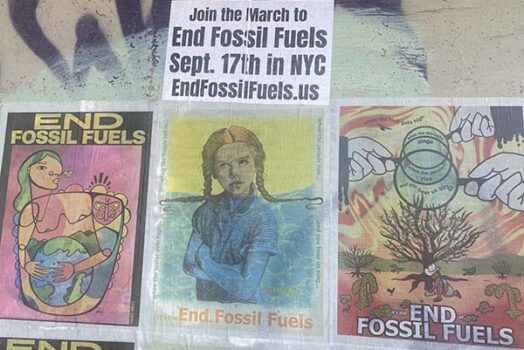
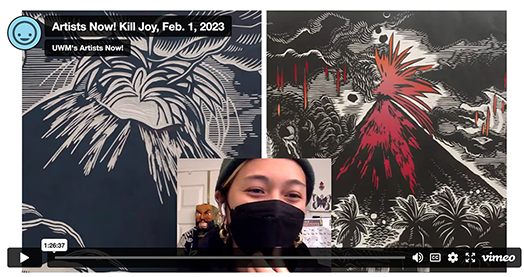
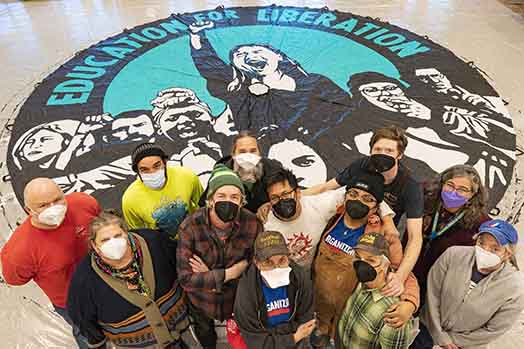
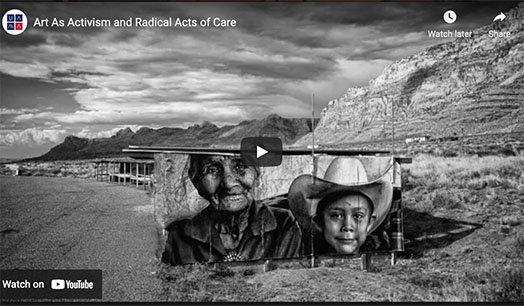
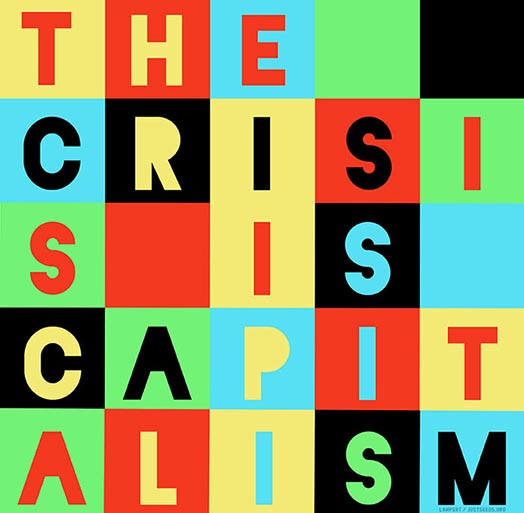
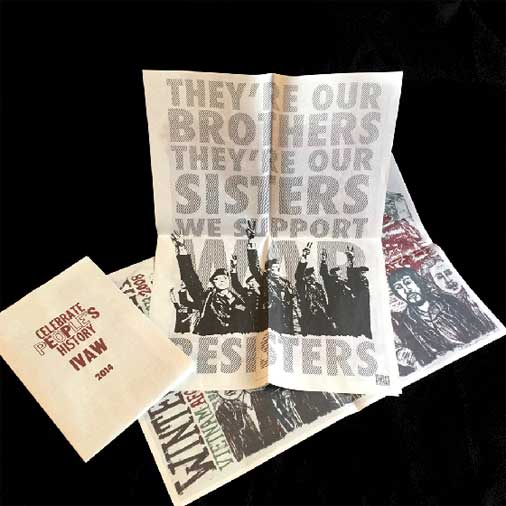
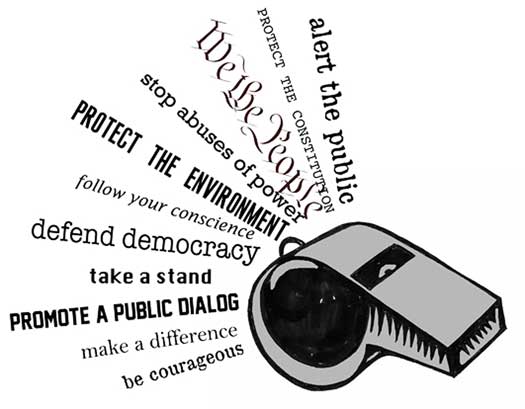

Good article, completely agree with the points about most street art being co-opted by commercialism. I gave up reading Wooster collective a long time ago because they’re well known to not publish politically contentious art in case it affects corporations giving them contracts for their advertising agency. So they keep it very conservative and are one of the main reasons that street art has become a hollow money making exercise.
Excellent analysis. You capture one of my problems with the contradictions implicit in “Exit Thru the Gift Shop.” On one hand, we see a real celebration of grassroots creative action, a sense of the thrill of major and minor transgression, and a practice that complicates notions of public space. On the other hand, we also witness the endless miasma of self-promotion, the burning desire to brand ourselves using the same strategies as the corporatist practices that we critique, and, most depressingly, the willingness to eviscerate discourse and complexity with self-congratulatory cleverness. As if, somehow, self-reflexivity and arch knowingness can compensate for real activism.
But then, why would we even think that a museum like Geffen would *not* pull such a self-negation? It is a lot like BP making “green” commercials… except that, in Geffen’s case, the artists involved feel that they are doing something else… (do the ad agencies that make the videos of sea turtles for BP feel that they are saving the world and speaking truth to power?)
Kudos to Blu for the moxie to move on. His piece was amazing in scope and clarity. Dietch must be a Democrat at heart: capitulating on the dance before it hits the dance floor!
Really good analysis of the “ignored censorship” that comes in the wake of the David Wojnarowicz debacle at the Smithsonian. Troubling that there are two very recent and very clear examples of our art institutions engaged in censorship.
Your analysis of the problems of street art leaving the street and moving into galleries and museums is also quite keen and perceptive, as befits your long involvement in the art form. I hope that young artists who are inspired by the street art read this post and recognize the ways that their art may be compromised–and are able to avoid it!
I’m posting a link to this piece on ArtSlant: Chicago.
This is a good piece Nicolas, hopefully not expressed too late to catch the attention of people interested in this dialogue.
To me, Controversy is Deitch’s M.O.
It is no surprise that the Blu wall was comissioned, then destroyed. I appreciate Blu’s attitude towards the experience, his minimal response expressing that he fulfilled his obligation, painted his mural. He doesn’t need to recreate anything.
Deitch has always taken advantage of the “authenticity” of the artists in his roster. If its ESPO-Stephen Powers, getting arrested days before the Marketplace installation was to open or the spectacle of Japanther playing from a Uhaul box-truck, crowds filling up the street, outside the Swoon exhibition opening.
He is perfectly aware of the exposure that this kind of controversy provides for his projects, nor is he afraid of bad press.
Does it appear that Art in the Streets, is Deitch’s attempt to reinforce the importance of the artist’s he’s represented, to canonize them, and make sure that the pieces he’s sold to collectors, accrue in value?
Deitch Projects took a hit as a result of the economic collapse in 2008, Fannie Mae & Freddie Mac were bailed out, two days after the opening of Swoon’s Swimming Cities of the Switchback Sea. The journey and exhibition incurred incredible high costs and sold very little.
Was Wall St too absorbed with its own troubles to go shopping for art?
So Deitch left the “commercial” arena for the museum. Is this exhibition a tip of the hat to all his collectors as well as recognition for artists active in building careers from street based work?
Wasn’t this a concern of many opponents to Deitch’s selection as the director of LA MoCA, the conflict of interest- commercial gallerist to Museum Director?
All of this behavior seems to blatantly illustrate the direction that Contemporary Art has taken. If Banksy’s documentary conveys one thing, it is the capability of producing hype to sell a vapid product.
Its the art market!!
(For history on the financialization of art, check out The Mona Lisa Curse
http://art-for-a-change.com/blog/2009/11/the-mona-lisa-curse.html)
January 4, 2011
A crew of street and graffiti artists, together with a handful of war veterans, gathered Monday night in the dark, empty parking lot of MOCA’s Geffen Contemporary in Little Tokyo to stage a guerrilla protest performance against the museum’s director, Jeffrey Deitch.
http://latimesblogs.latimes.com/culturemonster/2011/01/street-artists-protest-moca-geffen-contemporary-blu.html
One of the things I find interesting (in response to KC’s first posting) is how Deitch was able to reformulate an issue of censorship (with him in the thuggery role: potentially very negative, even for a controversy-monger) into an issue of “just being sensitive towards our dear neighbors…” That is pretty deft!… He (and of course, The Institution that He represents) get(s) to be all responsive and tender even while he is closing the lid on the very freedoms (speech, self-expression, artistic creativity, autonomous production…) that are the foundations of his career as impressario. This is all (actually) really sad, and I applaud the guerilla protest that is outlined in KC’s second post: at least *that* is an optimistic (and I bet, fun!) action with its roots in real discourse.
Thank you Nicolas.
Nicolas Lampert has this whole idea of street art being shown by a museum all wrong. Street art for many years was produced on the street because young artist’s needed a place to produce work. The street was their canvas, If one chose to be political so be it however much street art is about beauty not politics and a chance to be discovered. The Moca Museum show is about recognizing that beauty and telling the art establishment that those who produce street art are worthy of museum exhibitions.It is not about controversy or censorship. For the hundreds or even thousands that take to the street every day producing genius, I salute you and hope that finally this art form will be accepted as FINE ART.
I find the whole situation deplorable. I am an art collector whose collection includes Blu. To be fair to all, I do not know of one mural that Blu has made so bluntly political and I have seen many. Come to think of it I have never seen a Blu mural that is overtly political. Do you think Blu would ever paint an outdoor mural in their country that criticizes the Pope? I challenge Art Info to find a Blu mural that has political undertones! I feel Blu took advantage of Deitch’s generosity. He could have given that wall to any number of street artists. Blu choose to paint coffins with dollars on them as a shock factor. That’s offensive to me and any patriotic American. Blu should have known better and done something a little more tasteful.Blu did that wall to gain attention to themselves. Controversy sells art and they are more well known now than ever before !!
The problem not being addressed here is the romanticizing of the uneducated artist. Most so-called street artists are high school drop outs who hate not just the system, but anything that might hold sway over their narcissism. If this show were serious about supporting street artists it would relegate that to providing scholarships and real guidance to all the screwed up kids populating the world’s back alleyways with aerosol paint tins, crystal meth tins, and cliche tattoos.
Thanks, Nicholas, for the most thought-provoking article I’ve read in a long time.
By the way, I’m a patriotic American and didn’t find Blu’s mural offensive or particularly shocking. Just sad. Please don’t think you speak for all patriotic Americans, Leo. You are mistaken.
Well written and important article.
funny what you dont know, or maybe, you dont reference:
http://www.flickr.com/photos/iconsfornow/2841903809/in/photostream/
and
“I started writing graffiti in 1984 just as the Philadelphia Anti-Graffiti Network (P.A.G.N.) started. The looming presence of a government agency dedicated to stopping the expression that had just given me a voice affected how I wrote graffiti. When P.A.G.N. boss Tim Spencer declared there was no political graffiti, and certainly no graffiti of artistic merit in Philadelphia, I thought, ‘Cool, I will do that’. So I did. 25 years after then mayor Goode uttered his famous warning ‘No more Cornbread, no more Mr. Blint, no more Mr. Nice Guy’, I received handshakes and thanks from current mayor Nutter for my contributions to to the Philadelphia landscape. The irony is not lost on me that at this moment in Nueces County, Texas, 18 year old Sebastian Perez and 19 year old Ralph Mirabal have been sentenced to 8 years in jail for writing on fewer walls than we have in West Philadelphia. The marks they made will fade before they get out. But their lives are completely and irrevocably vandalized by an unrepentant tagger named Justice. – ESPO ICY” – from the book “A Love Letter For You”
“Critics are like eunuchs in a harem. They know how its done, they see it done every day, but they are unable to do it themselves.” – Brendan Behan
not your boy
S
“Maybe there are a lot of people in that community and the neighborhood nearby that really wanted somebody to say something graphically anti-war, on a wall they look at all the time. That, maybe would have been great, but nobody asked, who knows…”
Roger Peet
17min-
http://justseeds.org/blog/2011/03/roger_peet_lecture_on_justseed.html
For a short documentary on the protest of BLU’s mural censorship, see: http://www.youtube.com/user/CaneyheadPictures